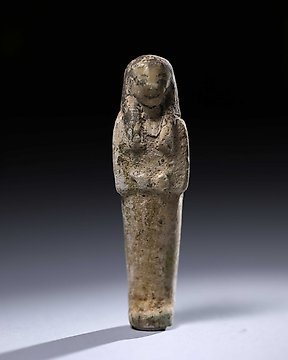
Ancient Egypt, New Kingdom Faience Shabti - 11.5 cm
No. 79933895

No. 79933895

ITEM: Scarab with seated Bes-deity holding offering above table and in front of an altar. Neb-sign below
MATERIAL: Steatite
CULTURE: Egyptian
PERIOD: New Kingdom, 1550 - 1070 B.C
DIMENSIONS: 12 mm x 10 mm
CONDITION: Good condition
PROVENANCE: Ex American egyptologist collection, active in the early part of the 20th century, brought to the US with the family in 1954.
The Egyptians saw the Egyptian scarab (Scarabaeus sacer) as a symbol of renewal and rebirth. The beetle was associated closely with the sun god because scarabs roll large balls of dung in which to lay their eggs, a behavior that the Egyptians thought resembled the progression of the sun through the sky from east to west. Its young were hatched from this ball, and this event was seen as an act of spontaneous self-creation, giving the beetle an even stronger association with the sun god’s creative force. The connection between the beetle and the sun was so close that the young sun god was thought to be reborn in the form of a winged scarab beetle every morning at sunrise. As this young sun god, known as Khepri, rose in the sky, he brought light and life to the land.
Scarab amulets were used for their magical rejuvenating properties by both the living and the dead. Scarabs were used by living individuals as seals from the start of the Middle Kingdom (ca. 2055 BCE) onwards. The most common inscription for these scarabs was the owner’s name. The incised design was often a schematic combination of hieroglyphs and geometric patterning. Patterns could often denote the specific administrative office held by the wearer.
Scarabs were also often rendered naturalistically in the round. The regenerative powers of scarabs of this nature could be used by either the living or the dead for healing and protection during quotidian activities or during a deceased person’s passage into the afterlife. The striking red/orange color of this amulet’s carnelian strengthens its solar associations.
Comes with Certificate of Authenticity and Export license
If you bid outside the european union and win the item, we will have to apply for an export licence for your country and shipping will take 3 to 5 weeks.
The Seller can prove that the lot was obtained legally , provenance statement seen by Catawiki.
How to buy on Catawiki
1. Discover something special
2. Place the top bid
3. Make a secure payment